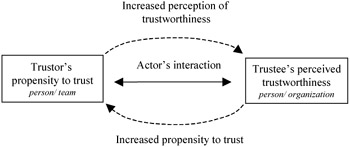Evolution of Trust
|
There is a strong temporal dimension in trusting. Trust is seen as evolving from past experience and current interaction (Deutch, 1973). It is seen as an outcome of a process, i.e., trust relationships develop gradually (Figure 3). Trust between partners can be said to be a bridge between past experiences and anticipated future experiences. In general, trust is believed to evolve slowly, through repeated interactions of increasing satisfaction (e.g., Blau, 1964) and through incremental investments and experiences. Reputation and experienced similarity both in character and values enhance the experience of trust (Zucker, 1987; Gulati, 1995; Jones & George, 1998) through the ability to predict the other one's behavior.

Figure 3: Trust as a Prediction Resulting from Satisfactory Interaction and Past Experience (Blomqvist, 2002)
Values are general principles or an individual's guiding system. They are relatively permanent and make a setting for the experience of trust. In the sense Jones and George (Figure 4) discuss values, they resemble the "basic assumptions" used by Schein (1992).

Figure 4: Experiencing Trust (Jones & George, 1998)(Adapted by Blomqvist, 2002)
Shared values have been pinpointed as antecedents of inter-organizational trust. Values can be seen as general principles that create a person's value system. Values guide the person's behavior and the interpretation of events and actions in the surrounding world (Jones & George, 1998, p. 532). Attitudes are composed of cognition-based trust, which may be based either on experiential or knowledge-based issues. In addition to experience, attitudes are also composed of more vague and very person-specific beliefs and thoughts about other people or organizations (see Jones & George, 1998, p. 533). Moods and emotions may play a major role in creating a first impression. First impressions are important since they set the tune for the relationship and enhance trust and relationship development(Nohria & Eccles, 1992; Young, 1995; Brown, 1998b). In the trust creation process, the parties exchange thoughts and feelings and are gradually able to develop attitudes towards each other. If they are able to take on the role of the other, i.e., feel sympathy, appreciation and understanding, they may be able to develop an attitude where they see the other as a trustworthy actor (Jones & George, 1998, p. 536).
Granovetter (1992, 34) argues that "in ongoing relations, human beings do not start fresh every day, but carry the baggage of previous interactions into each new one." The trustor's propensity (ability and willingness to trust) increases as the trustee behaves in a consistent and trustworthy manner (the person's integrity is evaluated and assessed by the trustor). The trust-creation cycle is enforced when the trustee experiences increased trust and is willing to stretch his role and increase his own trustworthiness. Luhmann (1983, p. 129) explains this in relation to double contingency as follows:
"One begins with small risks and builds on confirmations: and the conferral of trust is facilitated if this is required from both sides, so that the trust of one can find support in the trust of the other. Trust has circular, self-presupposing and confirming character that belongs to all structures emerging from double contingency."
It makes the formation of systems possible and, in return, acquires strength from them for increased, riskier reproduction.
The actors impact iteratively on the trustee's perceived trustworthiness and the trustor's propensity to trust (see Figure 5). Subsequently, the amount of overall trust in the relationship increases.

Figure 5: Interaction Dynamics of the Trustor and the Trustee (Blomqvist, 2002)
Jones and George (1998) see the development of trust as a developmental path from conditional trust to even unconditional trust (the development may also be backwards even to distrust). The parties may initiate a relationship under conditional trust, and deeper insight and knowledge of trustworthiness is gained through the process.
|
EAN: 2147483647
Pages: 143